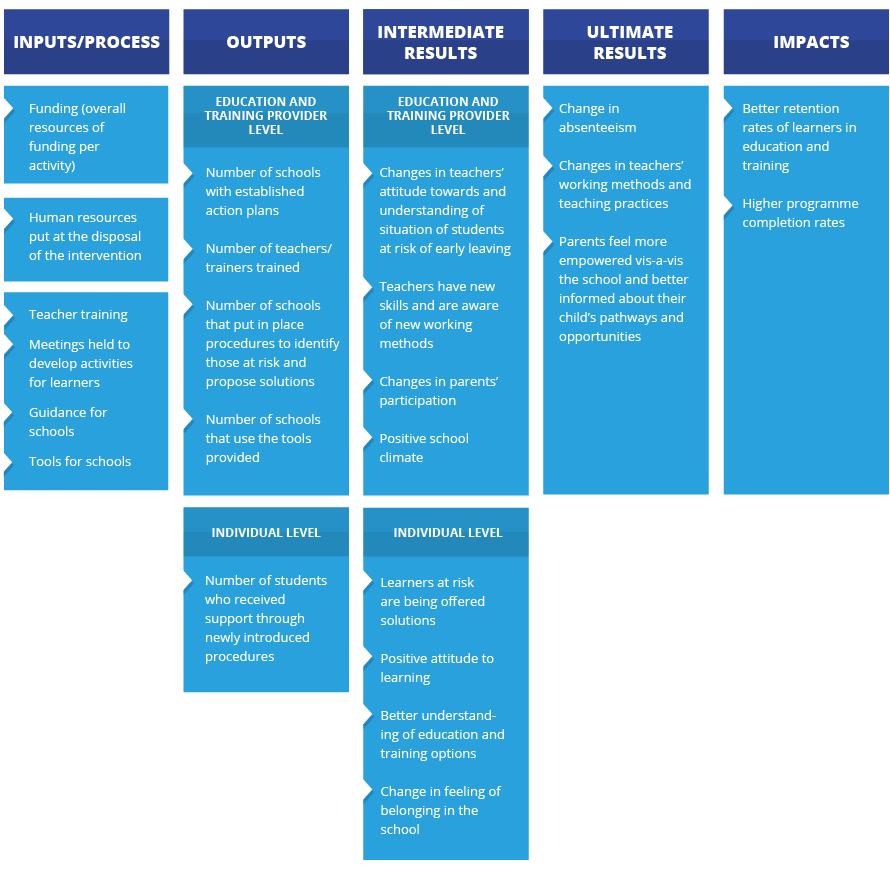Tackling early leaving from education and training requires schools/training providers to change their approach on how to manage this phenomenon. They need to change pedagogical approaches and also put in place measures to identify risks and propose solutions early so that young people do not disengage. Several programmes emphasise the importance of putting in place school-level action plans to tackle early leaving.
An evaluation of a scheme that stimulates school-level actions should start by clarifying how and why such action plans are expected to provide a solution to the problem, or part of it.
Factors at school-level play an important role in the causes that lead to early leaving. Examples of such causes are:
- teachers/leadership do not perceive dropping out as a problem. In fact if troublesome students leave this makes their job easier
- they do not feel accountable for retaining young people and leading them to a qualification
- teachers/leadership are not aware of the signs that signal disengagement, or even if they are, they lack the tools and skills to take action
- there is no relationship of trust between students and teaching staff
All these aspects mean that young people who face difficulties do not feel welcome or supported. As they start disengaging they do not receive any support or encouragement.
Programmes that promote school-level action plans typically aim to address these causes by, for example:
- strengthening the accountability of school leadership and teachers for the phenomenon of early leaving by expecting the schools to establish action plans and procedures to prevent early leaving
- raising awareness among staff about the negative consequences of early leaving
- providing training and practical tools to different profiles of staff
- raising awareness among staff about the importance of positive contact with parents and encouraging schools to put in place activities aiming at reaching out to parents
This is an example of an intervention logic for a school-level action plan aiming at preventing early leaving from education and training.

Indicative list:
- number of experts mobilised to provide training to teachers
- number of experts mobilised to support teachers in developing motivational activities for students
- budget allocated
- number of schools implementing the courses
- number and type of human resources mobilised
Indicative list:
- training for teachers (number of sessions delivered)
- meetings held to develop activities to motivate students (number of meetings)
- guidance for schools
- tools for schools
- training for teachers and its adequacy in relation to teachers’ needs
- number of teachers per class
- time devoted to individual support to learners outside regular school hours
Indicative list:
- number of schools with established action plans
- number of teachers/trainers trained
- number of schools that put in place procedures to identify those at risk and propose solutions
- number of schools that use the tools provided
- number of students who received support through newly introduced procedures
- number of students involved
- number of teachers involved
- number of parents involved
Indicative list of quantitative indicators :
- share of participating teachers who state that the training and meetings contributed to:
- increasing their understanding of the factors
- developing their skills to identify/support learners at risk of early leaving
- developing activities to motivate students
- changing their working methods and teaching practices
- share of participating students who state that the activities contributed to:
- increasing their satisfaction with the school
- increasing their motivation to study
- choosing their education or training programme
- share of participating students who:
- have lower absenteeism after participation in the programme
- improved their education performance after the programme
- share of participating parents who state that the activities contributed to:
- increasing their satisfaction with the school
- helping them support their children
Indicative list of qualitative indicators:
- narratives from beneficiaries about the differenced the new activities made to them. Stories about how the activities helped them:
- feel better at the school or training centre
- feel more motivated to study
- decide on their next steps
- narratives from teachers, trainers and other staff on what differences the activities made to the beneficiaries, and to the climate at the school or training centre
- narratives from parents on what differences the activities made to the beneficiaries
- change in teachers’ understanding of how to work with young people at risk of early leaving
- change in teachers’ teaching practice/methods
- change in teachers’ capacity to interact with students from various backgrounds
- the nature of the relationship between teachers and mentors
- young persons’ development of professional identity
- change in young persons’ self-confidence
Indicative list of quantitative indicators:
- share of participants who stay in education and training 3 months/6 months after the implementation of the school action plan
- share of participants who successfully complete their education/training programme
- share of participants who move on to further education/training
- share of participants who are in employment X years after completing their education/training programme
Indicative list of qualitative indicators:
- narratives from beneficiaries about how the activities they took part in helped them stay in education and training or complete their programme
- narratives from teachers, trainers or other staff about how the activities helped beneficiaries stay in education and training or complete their programme
- narratives from parents about how the activities helped beneficiaries stay in education and training or complete their programme
